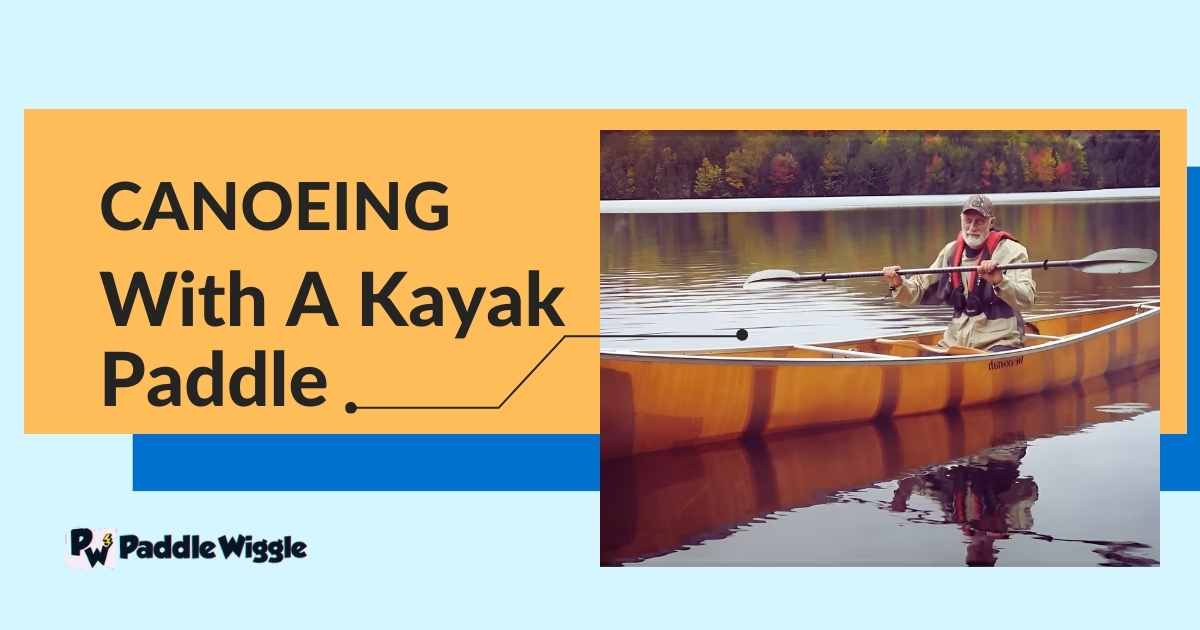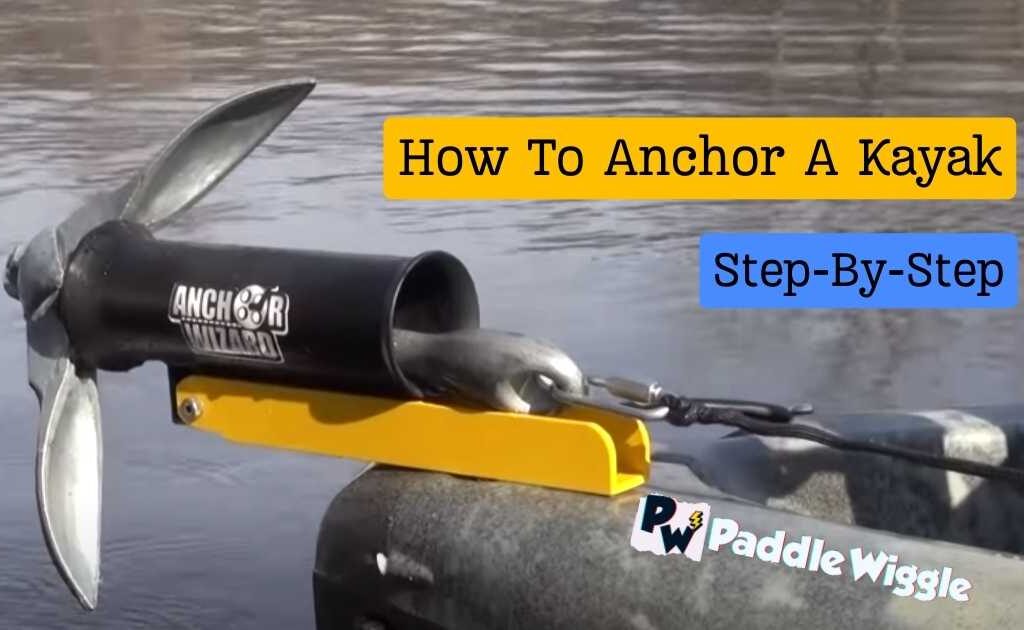Canoeing is an age-old water activity that has captivated outdoor enthusiasts for centuries. The serene glide of a canoe on calm waters offers a unique connection with nature.
But can you use a kayak paddle in a canoe? The short answer is YES, you can use a kayak paddle in a canoe.
Traditionally, canoes were propelled using single-blade paddles. However, a fascinating trend has emerged in recent years: canoeing with a kayak paddle. This intriguing blend of canoeing and kayaking techniques opens up new possibilities for waterborne adventurers.
In this article, we will explore the ins and outs of canoeing with a kayak paddle, including its benefits, techniques, skill development, and valuable tips.
Contents

Why Choose A Kayak Paddle For Canoeing? (10 Reasons)
Choosing a kayak paddle for canoeing offers a range of advantages that can enhance your canoeing experience. Here are some compelling reasons why you might opt for a kayak paddle when canoeing:
#1. Enhanced Control
Kayak paddles provide greater control over your canoe’s direction and speed due to their double-bladed design. This can be especially useful in windy conditions or when navigating narrow waterways.
#2. Efficiency
The symmetrical blades of a kayak paddle reduce the need for corrective strokes, making your paddling more efficient. This means you can maintain a straight course with less effort and cover longer distances comfortably.
#3. Improved Maneuverability
Kayak paddles are known for their maneuverability. With a kayak paddle, you can execute turning strokes like the sweep and draw with ease, making it simpler to navigate around obstacles or in tight spaces.
#4. Reduced Strain
Using a kayak paddle can distribute the physical effort more evenly between your arms, shoulders, and core muscles. This can help reduce strain and fatigue, allowing you to paddle for longer periods without discomfort.
#5. Versatility
A kayak paddle is versatile and suitable for various paddling conditions. Whether you’re on a calm lake, a flowing river, or even coastal waters, a kayak paddle can adapt to different environments.
#6. Faster Learning Curve
For beginners, kayak paddles can offer a faster learning curve. The symmetrical design and ease of use make it more accessible for those new to canoeing.
#7. Effective For Solo Canoeing
If you frequently paddle solo in a canoe, a kayak paddle can be particularly beneficial. It allows for efficient solo paddling as you can easily switch sides without changing your paddle’s orientation.
#8. Reduced Drips
While traditional single-bladed paddles often result in drips onto your lap, kayak paddles are less prone to this issue, keeping you drier during your paddle.
#9. Adaptation To Conditions
In challenging conditions like strong winds or currents, a kayak paddle’s efficiency and control can be especially advantageous, allowing you to maintain stability and stay on course.
#10. Hybrid Techniques
Canoeing with a kayak paddle opens up opportunities for hybrid techniques, where you can blend canoe and kayak paddling styles for unique and effective maneuvers.
Canoeing With A Kayak Paddle: Ins And Outs


Canoeing with a kayak paddle can be a thrilling and adventurous experience. While traditionally, canoes are propelled with a single-bladed paddle, using a kayak paddle opens up a whole new world of possibilities.
Let’s explore the ins and outs of canoeing with a kayak paddle:
Learn Proper Technique And Stroke Mechanics
It’s essential to learn the proper technique and stroke mechanics. Unlike using a traditional canoe paddle, using a kayak paddle in a canoe requires some adjustments. To get started, make sure you have the right size paddle for your height and boat width. A general rule of thumb is that the paddle should be about 6-12 inches longer than your height.
Adjust Your Seating Position And Posture
To optimize performance with a kayak paddle in a canoe, it’s crucial to adjust your seating position and posture. Sit in the center of the canoe with your feet positioned comfortably on the foot braces or against the sides of the boat.
This will provide stability and control as you maneuver through the water. Keep your back straight and engage your core muscles to maintain balance.
Practice Different Strokes For Effective Canoeing
To become proficient at canoeing with a kayak paddle, practice different strokes that are effective for maneuverability. The forward stroke is used for propelling yourself forward in a straight line. Start by planting the blade fully into the water near your toes, then pull it back alongside the boat while rotating your torso slightly. Repeat this motion on both sides of the canoe.
The sweep stroke is used for turning or changing direction quickly. Begin by placing one blade near your hip, angled away from the boat. Push outwards while sweeping towards the stern of the canoe in an arc motion. This will help you turn efficiently without losing momentum.
The draw stroke is used for moving sideways or pulling yourself towards an object like a dock or another boat. Place one blade perpendicular to the side of the canoe and pull it towards you while keeping it close to the hull.
Technique For Canoeing With A Kayak Paddle


To make the most of canoeing with a kayak paddle, it’s crucial to master the right techniques. Proper hand placement on the paddle shaft ensures efficient strokes and minimizes stress on the wrists. Understanding the nuances of the forward stroke, including the catch, power phase, and exit, is essential for maintaining a straight line and maximizing speed.
Canoeists also need to learn turning strokes like the sweep stroke and draw stroke for effective navigation.
Learning bracing techniques is vital for stability and safety, especially in rough waters. High and low brace strokes are valuable skills that help maintain balance and avoid capsizing in challenging conditions.
Proper Grip And Hand Placement
When canoeing with a kayak paddle, it’s important to have a proper grip and hand placement on the shaft. Hold the paddle with both hands slightly wider than shoulder-width apart.
Your top hand should be positioned near your eye level while your bottom hand rests lower down on the shaft. This grip allows for better control over your strokes and helps minimize strain on your wrists.
Efficient Forward Stroke Technique
The forward stroke is fundamental to moving efficiently through water when canoeing with a kayak paddle. To execute this technique effectively:
- Start by reaching forward with your top hand while keeping your arms straight.
- Submerge the blade fully into the water at an angle.
- Engage your core muscles as you pull back towards your hip using smooth, continuous motion.
- Rotate your torso slightly during each stroke to generate more power.
Remember to keep your paddle close to the side of the boat throughout each stroke to maintain stability.
Utilizing The Catch And Power Phase Of The Stroke
The catchphrase refers to how you initiate each stroke by placing the blade into the water smoothly without splashing or creating unnecessary resistance. The power phase follows immediately after, where you apply force against the water using a combination of your arms, core, and torso rotation. This phase is crucial for generating propulsion and speed in your canoe.
Maintaining Balance And Stability While Paddling
To maintain balance and stability when canoeing with a kayak paddle:
- Keep your weight centered in the boat.
- Engage your core muscles to help stabilize your body.
- Use a slight lean towards the opposite side of your paddle stroke to counterbalance.
- Practice bracing techniques such as the high brace and low brace strokes to recover from potential tipping or capsizing situations.
By mastering these techniques, you’ll be able to enjoy smoother, more efficient paddling experiences while canoeing with a kayak paddle. Remember, practice makes perfect! The more you get out on the water and try these techniques, the better you’ll become at maneuvering through different conditions.
Comparison: Kayak Paddle Vs. Canoe Paddle In A Canoe
When it comes to paddling in a canoe, the choice of paddle can make a big difference in your experience on the water. Two popular options are the kayak paddle and the canoe paddle. While both are designed for paddling, they have distinct differences that can affect your performance and comfort.
In this comparison, we will explore the characteristics of each paddle and discuss their pros and cons when used in a canoe.
| Aspect | Kayak Paddle in a Canoe | Canoe Paddle in a Canoe |
|---|---|---|
| Blade Design | Double-bladed, symmetrical | Single-bladed, asymmetrical |
| Control | Enhanced control and maneuverability | Good control but may require more corrective strokes |
| Efficiency | More efficient, less need for corrective strokes | Efficient but may require more effort on longer trips |
| Maneuverability | Excellent maneuverability, easy turning strokes | Good maneuverability, turning strokes may be different |
| Strain Reduction | Distributes effort evenly, reduces strain | More strain on one side, can be tiring on long trips |
| Learning Curve | Generally easier for beginners | May have a steeper learning curve for beginners |
| Solo Paddling | Well-suited for solo paddling with efficient switching | Suitable for solo paddling, requires hand switching |
| Drips | Minimal dripping, keeps paddler drier | More dripping onto the lap, can be wetter experience |
| Versatility | Versatile for various paddling conditions | Versatile for various paddling conditions |
| Wind & Currents | Effective in challenging conditions, better stability | Effective but may require more effort in conditions |
| Hybrid Techniques | Enables hybrid techniques for unique maneuvers | Requires traditional canoe paddling techniques |
Increased Speed Vs. Better Maneuverability
One of the key differences compared to using a traditional canoe paddle is the trade-off between speed and maneuverability. A kayak paddle offers increased speed due to its design, with longer blades that allow for efficient propulsion through the water.
On the other hand, a traditional canoe paddle provides better maneuverability, allowing you to navigate tight turns and make quick adjustments while paddling.
Traditional Canoe Paddle (Pros):
- Better maneuverability for navigating tight turns
- Quick adjustments while paddling
- Well-suited for exploring winding rivers and narrow waterways
Lighter And Easier To Handle
Another advantage of using a kayak paddle in a canoe is its weight and ease of handling. Kayak paddles are typically lighter than bulky canoe paddles, making them more comfortable to use over extended periods.
The lightweight nature of kayak paddles allows for less strain on your arms and shoulders, enabling you to enjoy your canoeing adventure without feeling fatigued too quickly.
Canoe Paddle (Pros):
- Provides more stability due to its size and shape
- Suitable for individuals who prefer a solid grip on their paddle
- Offers greater control when bracing against obstacles or currents
Versatility In Shallow Or Narrow Waterways
While both types of paddles can be used in various water conditions, canoe paddles have an advantage. The design of a canoe paddle allows for greater versatility in these situations, as its shorter length and wider blade make it easier to paddle through shallow waters without hitting the bottom or getting stuck.
Advantages Of Using A Double-Bladed Paddle For Solo Canoeing
One of the first questions that arise is, “Why use a kayak paddle in a canoe?” The answer lies in the array of benefits it offers:
Enhanced Paddle Control
A kayak paddle allows for increased control and precision in maneuvering a canoe. The symmetrical design of the paddle blades permits easy switching between sides, improving steering accuracy.
Efficiency And Speed
Canoeing with a kayak paddle can result in greater efficiency and speed. The double-bladed paddle reduces the need for corrective strokes, helping maintain a straight course and conserve energy.
Improved Maneuverability
Kayak paddles are renowned for their maneuverability. Canoeists can easily execute turning strokes, such as the sweep stroke and draw stroke, with a kayak paddle, making navigating narrow waterways or negotiating obstacles more accessible.
Reduced Strain
The use of a kayak paddle often reduces strain on the body. Paddlers can employ a variety of techniques that engage different muscle groups, distributing the effort and minimizing fatigue.
Versatility
A kayak paddle equips canoeists to tackle diverse paddling conditions. Whether you’re on a calm lake, a swift river, or exploring coastal waters, the adaptability of a kayak paddle makes it an excellent choice.
Solo canoeists benefit from the efficiency of using both sides of the double-bladed kayak paddle. By utilizing both blades simultaneously, they can generate more power with each stroke compared to using just one blade.
With proper technique, solo paddlers can maintain better balance and control with the use of a double-bladed paddle. Since they have two blades to work with instead of one, they can distribute their efforts evenly on both sides to keep their canoe steady and balanced.
Double-bladed paddling also reduces fatigue during long solo trips by evenly distributing effort on both sides of the body. This balanced paddling style allows paddlers to engage different muscle groups, preventing excessive strain on a single side.
Moreover, using a kayak paddle in a canoe provides an opportunity for solo canoeists to explore different stroke techniques. They can master various strokes like the forward stroke, reverse stroke, and sweep stroke, which offer better control and precision in maneuvering the canoe.
In addition to these advantages, kayak paddles are available in different materials, such as aluminum, fiberglass, and carbon fiber. Each material has its own unique characteristics that cater to different preferences and budgets. For example, nylon blades are more affordable and durable compared to fiberglass or carbon fiber blades.
Final Words
Again, you can use kayak paddles in a canoe, and it’s a great idea! This choice opens up many possibilities because these paddles are versatile and efficient. With a kayak paddle, you can easily paddle on calm waters or tackle more challenging conditions. It helps you control your canoe better, turn more smoothly, and reduce tiredness so that you can paddle comfortably for longer.
So, why stick to traditional canoe paddles when you can fully embrace the benefits of using a kayak paddle for canoeing? Give it a try, and you’ll feel the difference for yourself.



